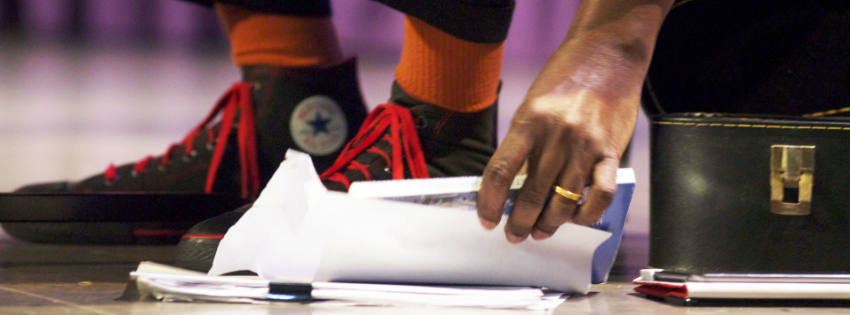Poets, Photographers, and Poet-Photographers (Part Two)
News

by Karen Risch Mott
During the first Furious Flower Poetry Conference in 1994, Erica Cavanagh was a reporter for James Madison University’s student paper, The Breeze. She shot in black and white and developed her own film in the campus darkroom to document the historic gathering of poets and academics.
Last fall, Cavanagh returned to the Furious Flower conference as a seasoned professor, a member of the JMU English faculty since 2007. (In the intervening years, she’d finished her bachelor’s degree at JMU and earned a master’s degree at the University of Chicago, where she focused on African American literature. She received an MFA in nonfiction from the University of Iowa.) She photographed the 2014 conference for her own enjoyment, using a digital camera to capture images of many of the same poets who’d inspired her 20 years ago, such as Rita Dove and Nikki Giovanni. She also found herself captivated by many of the writers she hadn’t seen in person before and was particularly taken with Afaa Michael Weaver, Thomas Sayers Ellis, and Patricia Smith.
She may have the least number of photographs of those who commanded her attention the most. “It’s hard to photograph and listen at the same time,” Cavanagh admits. “There’s a dance of being respectful of the space of the speakers and audience. It’s definitely a negotiation: when to capture versus when to take in the words and be more present. … Documenting does separate me from the experience a bit.” So she gave herself permission to put down the camera.
Cavanagh’s interest in photography began many years ago, long before she arrived at JMU. “My mother took photos with a 35mm Minolta,” she remembers. Recently, she discovered that her great-great-great aunt Sarah Jane Dudley practiced photography shortly after the camera was invented. Dudley’s images appear in a couple books of collected photos, including one commemorating the growth of a textile company and the surrounding town in Whitinsville, Massachusetts. Cavanagh describes these turn-of-the-century photos as having “a still-life quality, whether of cyclists lined up before a race, Holstein cows, or river landscapes.” She also has a few portraits of Dudley, one of them showing her “under a cloaky lens hood peering into her camera on a tripod.”
Unconstrained by the long exposure times Dudley endured, Cavanagh was able to pursue more lively subjects. Even as a girl, she was “fascinated by how much expression could be in faces and gestures.” She was also “obsessed by the idea of time passing too quickly” and saw photography as a way to halt it, if only for a moment. A native of Rochester, New York, she began photographing in seventh grade, and during high school when she got her first job at Wegmans her first few paychecks went to buy a Minolta x-700.
Her connection to African American culture began in childhood; she grew up as a member of a predominantly black Catholic congregation with “a huge black Jesus at the front of the church,” banners in African colors, and stories of Sojourner Truth, Harriet Tubman, and Martin Luther King, Jr. commingled with those of the Old and New Testament. Her father had decided to take the family there shortly after her baptism in a mostly white church, which he found cold and “too starched.” By contrast, their new church family embraced one another, welcoming them into its midst.
Her interest in poetry was stoked by her roommate in college, Hilary Knause, who had books by Nikki Giovanni, Alice Walker, and Marge Piercy. “Our idea of a good time was to read poems … about being a woman and not taking any shit.” In her junior year, she took Dr. Joanne Gabbin’s class, African American Poetry, and the language felt familiar yet new and exciting. “I was learning the particularities of expression.”
In her own forms of expression, both photography and writing (and teaching, too), Cavanagh continues to explore the theme of memory: “What is seen, experienced and heard, though fleeting, has tenacity in the mind and body.” Images, poems, and essays all have a similar aim, she believes: to “document the persistence of memory or to make memories that otherwise may be lost to the busyness of life.”
Erica Cavanagh teaches Survey of African American Literature and several creative nonfiction workshops at James Madison University. She shot the images featured in the slideshow at the top of this article with a Nikon D200. View more of her photos of the 2014 Furious Flower Poetry Conference on Flickr.
